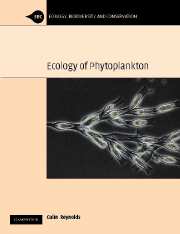Book contents
- Frontmatter
- Contents
- Preface
- Acknowledgements
- Chapter 1 Phytoplankton
- Chapter 2 Entrainment and distribution in the pelagic
- Chapter 3 Photosynthesis and carbon acquisition in phytoplankton
- Chapter 4 Nutrient uptake and assimilation in phytoplankton
- Chapter 5 Growth and replication of phytoplankton
- Chapter 6 Mortality and loss processes in phytoplankton
- Chapter 7 Community assembly in the plankton: pattern, process and dynamics
- Chapter 8 Phytoplankton ecology and aquatic ecosystems: mechanisms and management
- Glossary
- Units, symbols and abbreviations
- References
- Index to lakes, rivers and seas
- Index to genera and species of phytoplankton
- Index to genera and species of other organisms
- General index
Chapter 1 - Phytoplankton
Published online by Cambridge University Press: 07 August 2009
- Frontmatter
- Contents
- Preface
- Acknowledgements
- Chapter 1 Phytoplankton
- Chapter 2 Entrainment and distribution in the pelagic
- Chapter 3 Photosynthesis and carbon acquisition in phytoplankton
- Chapter 4 Nutrient uptake and assimilation in phytoplankton
- Chapter 5 Growth and replication of phytoplankton
- Chapter 6 Mortality and loss processes in phytoplankton
- Chapter 7 Community assembly in the plankton: pattern, process and dynamics
- Chapter 8 Phytoplankton ecology and aquatic ecosystems: mechanisms and management
- Glossary
- Units, symbols and abbreviations
- References
- Index to lakes, rivers and seas
- Index to genera and species of phytoplankton
- Index to genera and species of other organisms
- General index
Summary
Definitions and terminology
The correct place to begin any exposition of a major component in biospheric functioning is with precise definitions and crisp discrimination. This should be a relatively simple exercise but for the need to satisfy a consensus of understanding and usage. Particularly among the biological sciences, scientific knowledge is evolving rapidly and, as it does so, it often modifies and outgrows the constraints of the previously acceptable terminology. I recognised this problem for plankton science in an earlier monograph (Reynolds, 1984a). Since then, the difficulty has worsened and it impinges on many sections of the present book. The best means of dealing with it is to accept the issue as a symptom of the good health and dynamism of the science and to avoid constraining future philosophical development by a redundant terminological framework.
The need for definitions is not subverted, however, but it transforms to an insistence that those that are ventured are provisional and, thus, open to challenge and change. To be able to reveal something also of the historical context of the usage is to give some indication of the limitations of the terminology and of the areas of conjecture impinging upon it.
So it is with ‘plankton’. The general understanding of this term is that it refers to the collective of organisms that are adapted to spend part or all of their lives in apparent suspension in the open water of the sea, of lakes, ponds and rivers.
- Type
- Chapter
- Information
- The Ecology of Phytoplankton , pp. 1 - 37Publisher: Cambridge University PressPrint publication year: 2006
- 4
- Cited by

